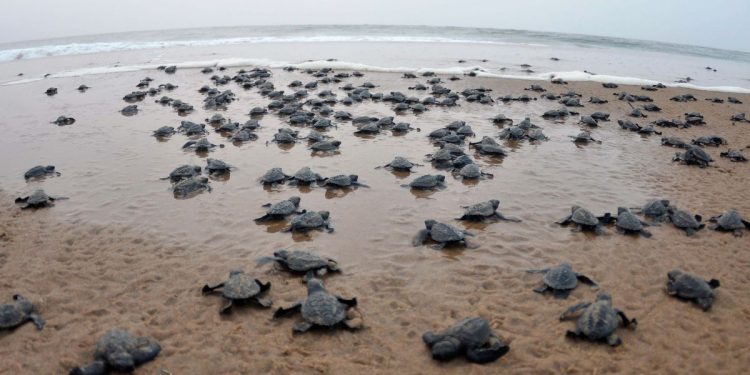Kendrapara: Gahirmatha beach in Kendrapara district, the world’s largest rookery of the endangered Olive Ridley sea turtles, may witness a second mass nesting of the species in the coming days, forest officials said Tuesday.
Over five lakh turtles have so far converged on the beach for mass nesting that commenced February 27, said SA Mishra, assistant conservator of forest, Rajnagar mangrove (wildlife) forest division.
“We are hopeful of turtles’ en-masse arrival on the beach to lay eggs for the second occasion this year because of perfect topography of the beach,” he said.
“We are of the view that with the climatic condition being conducive and beach topography ideal, the turnout of these marine creatures would recur again anytime between March last week and April first week,” the official said.
Earlier on one occasion, second mass nesting of turtles had been recorded on the Gahirmatha beach.
Excellent profile of the beach, strong southerly winds and atmospheric temperature ranging from 32 to 38 degree Celsius are conducive for turtles mass nesting. This year, everything was perfect leading to virtual invasion of turtles to the nesting ground. So we are optimistic that turtles would reappear on the beach for mass nesting, he said.
Besides this year there was intense crackdown on illegal trawling in Gahirmatha Marine Sanctuary to ensure the safety of turtles. These marine species often perish after getting hit by trawler propeller or entangled in fishing nets, the official said.
As many as 92 sea-worthy fishing trawlers were seized this year by patrol teams while 762 crew members of trawlers were arrested for sneaking into the prohibited sea waters. Fish catch seized from intercepted trawlers was later auctioned and it fetched revenue to the tune of Rs 75 lakh, a record figure, the official claimed.
The nesting ground at Gahirmatha, which recently played host to nearly five lakhs of female Olive Ridley turtles for their annual mass nesting, has now got elongated to 2.6 km stretch following natural accretion process.
The beach at the unmanned Nasi-II Island of Gahirmatha, now rechristened as APJ Abul Kalam Island, is providing perfect and congenial ambience for the nocturnal visitors to lay eggs because of the elongation of the beach profile.
As the nesting beach is widespread in length, the marine animals get ample space to loiter around the beach to dig pits at their favoured spots and lay eggs.
It’s only the female turtles that virtually invade the nesting beaches usually at the dead of the night for laying eggs, the phenomenon otherwise described as ‘arribada’ in Spanish.
After indulgence in instinctive egg-laying, the turtles leave the nesting ground to stride into the deep sea water. Hatchlings emerge from these eggs after 45-60 days. It is a rare natural phenomenon where the babies grow without their mother, said officials.
PNN







































